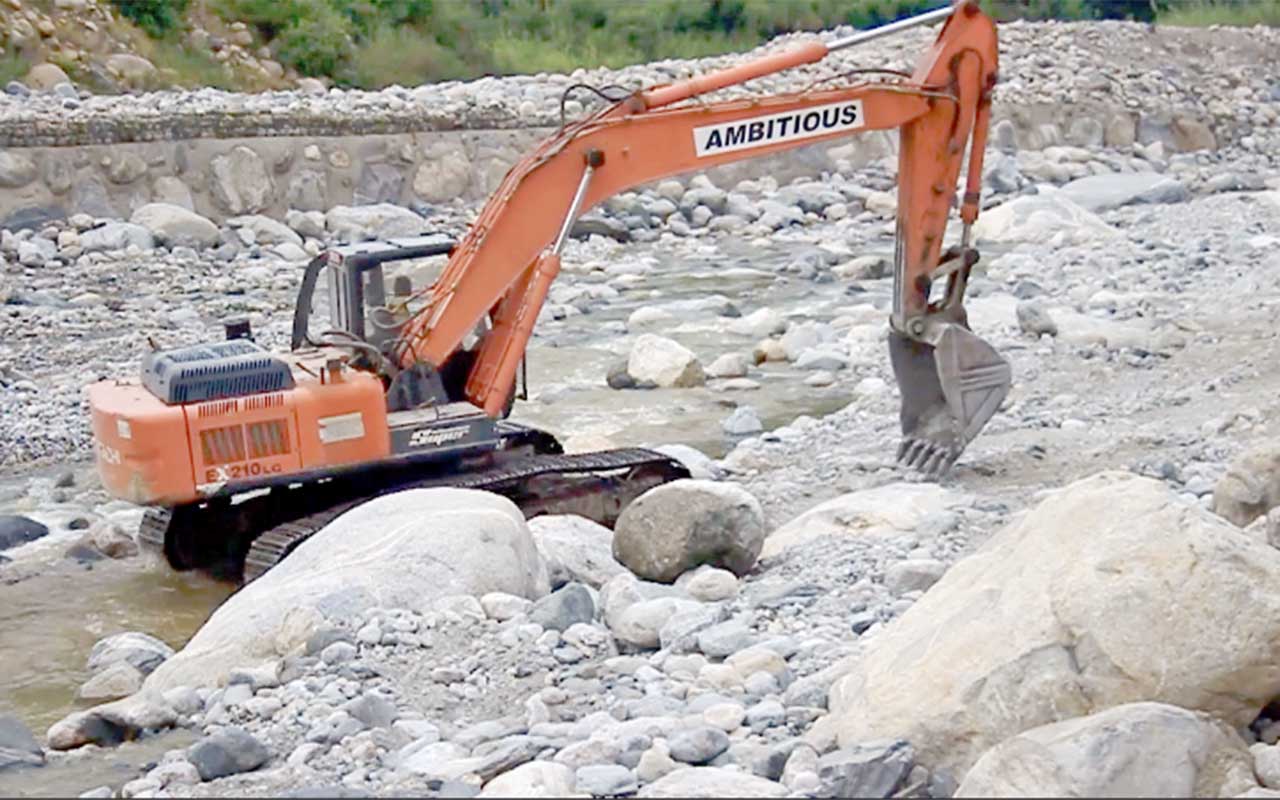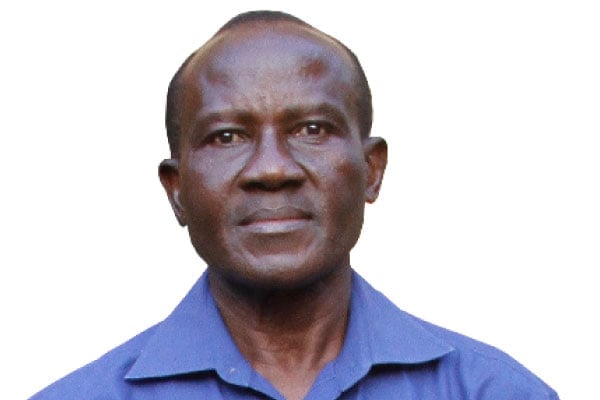Prime
How desilting Nyamwamba will save lives in Kasese

Above: An excavator desilting 5.4 kilometre stretch of River Nyamwamba. PHOTOS /JOEL KAGUTA
What you need to know:
- In May, major rivers in Kasese district, streaming from Mt. Rwenzori, burst their banks, wrecking havoc. Climate change was blamed for the disaster with experts saying too much rain fell within a short period of time, causing the rivers to overflow. As Joel Kaguta writes, desilting Kasese’s rivers could be a huge step in mitigating the effects of climate change.
Sunday Salveri was one of the fish farmers operating in the Nyamwamba valley. At the beginning of the year, there were about 500 fishponds in the valley, supplying hotels and restaurants in the Kasese district with different species of fish.
To feed his fish, Salveri had planted sugarcane and mango trees on the upper side of his farm in the valley. Business was thriving.
“I had four fishponds, with the largest containing 2,500 fish. I had planned to harvest tilapia and catfish in July. My estimates were that I would earn Shs3.5 million from the catch and reinvest Shs500,000 back into the business,” he says.
Unfortunately, his dreams came to a brutal end in May when rivers Nyamwamba, Lhubiriha, Nyamughasana, and Mubuku burst their banks, destroying everything in their path across nine sub-counties and three divisions of Kasese town.
“My farm is 200 metres away from the banks of River Nyamwamba but that did not stop the river from washing away all the 500 fishponds. We tried to guard against the water but the floods were above the level of the fishponds. I lost everything; two ponds which were ready for harvest and a hatchery,” he says.

Sunday Salveri, fish farmer in Nyamwamba valley 2.
Miraculously, his sugarcane and mango trees survived. Of the 500 fishponds, only five fish farmers have been able to rebuild what the floods destroyed.
“If River Nyamwamba is not desilted, fish farming will cease to exist in Kasese district. I have to take a loan from the bank to revamp my fish farm and it will be one and a half years before I can harvest anything. The sugarcane and mango trees were supposed to feed the fish, but now everything is rotting,” Salveri laments.
Desilting is the removal of sand, clay, soil, rocks and any other material carried by running water and deposited into a water channel or harbor. It restores the natural capacity of the water channel without widening or deepening it.
Encroachment in the Nyamwamba valley
Over the course of ten years, Kasese’s rivers have been flooding with alarming regularity. The previous floods occurred in the months of May in 2013, 2014, 2015, 2016, 2017, and 2020.
Dr. Callist Tindimugaya, the Commissioner for Water Resources Planning and Regulation in the Ministry of Water and Environment (MWE), says when storm water moves downhill, it carries with it soil that is deposited into a river.
“In the case of River Nyamwamba, a few years ago, there was a fire that ravaged the Rwenzori Mountains National Park, exposing the soil and rocks. So, whenever it would rain, the fast flowing storm water would come with huge chunks or rocks and deposit them in the river,” he says.
The community in the Nyamwamba valley has been entirely dependent on the catchment area for their livelihood, engaging in agriculture with poor farming methods, tree cutting and sand mining. These activities have loosened the soil, which flows easily with the storm water, since there are no trees to stop it.
“The material deposited into the river fills it up, making its flow difficult. Some of the rocks, as they are falling, destroy the riverbank in some sections. During the rainy season, the river will fill up and the water will overflow, creating its own channels, flooding the communities around. A number of people have been killed by the floods which found them in their gardens in the Nyamwamba valley,” Dr. Tindimugaya says.
Ms Judith Bwenge, the district environment officer, says the flooding indicates that nature is taking its course.
“The rate at which people have encroached on the Nyamwamba valley is alarming. As a district, we have done our part, holding awareness and sensitisation sessions every four months within the communities living in the flood prone areas. Our message is that they should move away from the river,” she says.

Ms Judith Bwenge, Kasese District Assistant Environmental Officer in-charge of Swamps.
She advises those who eke out their livelihoods in the valley to move further upstream so that they are not affected when the water volumes rise.
“The riverbanks are the main control water system we have. Once they are destroyed, you can be sure that any increment in water volumes is going to cause havoc. Even if the valley is dry, when you see identifiers such as vegetation, boulders, just know that there was water there and it will definitely come back,” she advises.
Expensive venture of desilting
Over the years, storm water has deposited material into River Nyamwamba and other rivers in Kasese. According to Richard Bomera, the LC3 chairperson of Bulembia Division in Kasese Municipality, the only course of action to save the community is to desilt River Nyamwamba.

Richard Bomera, the sub-county chairperson for Bulembia Division in Kasese Municipality.
“Years ago, when Kilembe Mines (Limited) was still vibrant, they had a department responsible for water. That department used to desilt the river every year, to remove soil and boulders, and to rebuild its banks. At that time, the river was very deep. You would hardly know there was a river there,” he says.
In 2022, the government, through MWE, lobbied for funds from the World Bank specifically to deal with the River Nyamwamba Catchment Area. Bomera, who is also the chairperson of the Nyamwamba Catchment Management Committee, says the idea was to first restore the vegetation before desilting the river.
“We got a tree planting project and other projects aimed at creating alternative livelihoods for the encroachers, such as an apiary and coffee value chain development. It was a contract of Shs15 billion given to three firms, and all the activities are ongoing. For instance coffee processing plants were constructed in Kyanjuki, Mbunga and Kilembe areas,” he says.

Workers construct the riverbank with wire mesh gabions.
The next phase was to desilt parts of the river, restoring its bank and stabilise it.
“As we removed the rocks and soil, in some areas we put concrete and wire mesh gabions were constructed to help the river return to its course, so that when it is moving, it does not destroy the riverbank,” Dr Tindimugaya says.
A gabion is a wired basket filled with rocks that prevents soil erosion. It is commonly used in riverbanks and areas with steep slopes. The Shs19.7 billion project was intended to work on only a 5.4 kilometre stretch of the river from Kilembe Secondary School to River Ngangi.
“If the entire river is to be desilted, it would cost the government over Shs150 billion. The low funds available meant that the government had to first consider the critical section, which has government installations that need to be protected. These include Kilembe Mines Hospital, Kilembe Mines Offices, Kilembe Secondary School, Mt. Rwenzori Girls School, and the offices of Bulembia sub-county,” Bwomera says.
Dr Tindimugaya says the cost of desilting the entire 21 kilometre stretch of River Nyamwamba will depend on the materials deposited into the river.
“Very huge rocks from Mt Rwenzori have been deposited in the Nyamwamba river bed. We need heavy equipment to remove them. The cost also depends on how deep and wide the river is. In some areas, the river is 30 metres deep,” he says.
However, in May 2024, River Nyamwamba flooded again, washing away all the wire mesh gabions and destroying most of the work done. However, Bulembia, where the concrete gabions had been placed, was not affected by the floods.
Dr. Tindimugaya says the works done in 2022 were emergency works that were done without a geotechnical survey, to save lives.
“Previously, people were dying during the floods. Yes, some of the emergency gabions we put in place were washed away, but the bridges and hydropower stations were not washed away. More importantly, no one died in the recent floods. The project had an insurance cover and that is what the contractor is now using to do repairs until next month,” he says.
Bomera says the destruction of the gabions is just a challenge that has helped the team change their method of work.
“Because the rocks from Mt Rwenzori crushed the wire mesh gabions, the construction company is now using only concrete gabions. The gabions are being planted deep into the river basin. They are putting very big boulders in the riverbank and reinforcing them with concrete,” Bomera says.
The way forward
Dr Tindimugaya says next month, the MWE will commence a geotechnical survey to determine how thick the material that has been deposited in River Nyamwamba is, how wide the river is, and what section needs to be protected.
“We also need to determine where the rocks we remove are going to go. In the 5.4 kilometres, some of the rocks were used in the wire mesh gabions. However, some of the rocks and soil have to be carried away and this is a cost in terms of transport,” he says.
During this phase of the work, the river has also been demarcated with bamboo boundaries planted in the protection zone to hold the soil strongly. Check dams have also been constructed in the hills to reduce the speed of River Nyamwamba.
Bomera says the government has secured more funding to a tune of Shs 97 billion to commence the second phase of the project.
“The government has agreed to procure equipment in Phase Two. We are going to procure three excavators and two bulldozers that we will use to periodically desilt the river once the contractor leaves,” he says.
Desilting the river and restoring the riverbank has not stopped at River Nyamwamba. While the local governments cannot afford to desilt rivers in their area, they have secured funds to carry out mitigating activities on the riverbanks, such as planting bamboo and fruit trees along small rivers.
General Manager Editorial Daniel Kalinaki. Weekend Editor Robert Madoi. Sustainability Hub Editor Gillian Nantume Features Editor Caesar Karuhanga Abangirah
Contributors Joel Kaguta
Produced by Nation Media Group in partnership with the Bill & Melinda Gates Foundation




